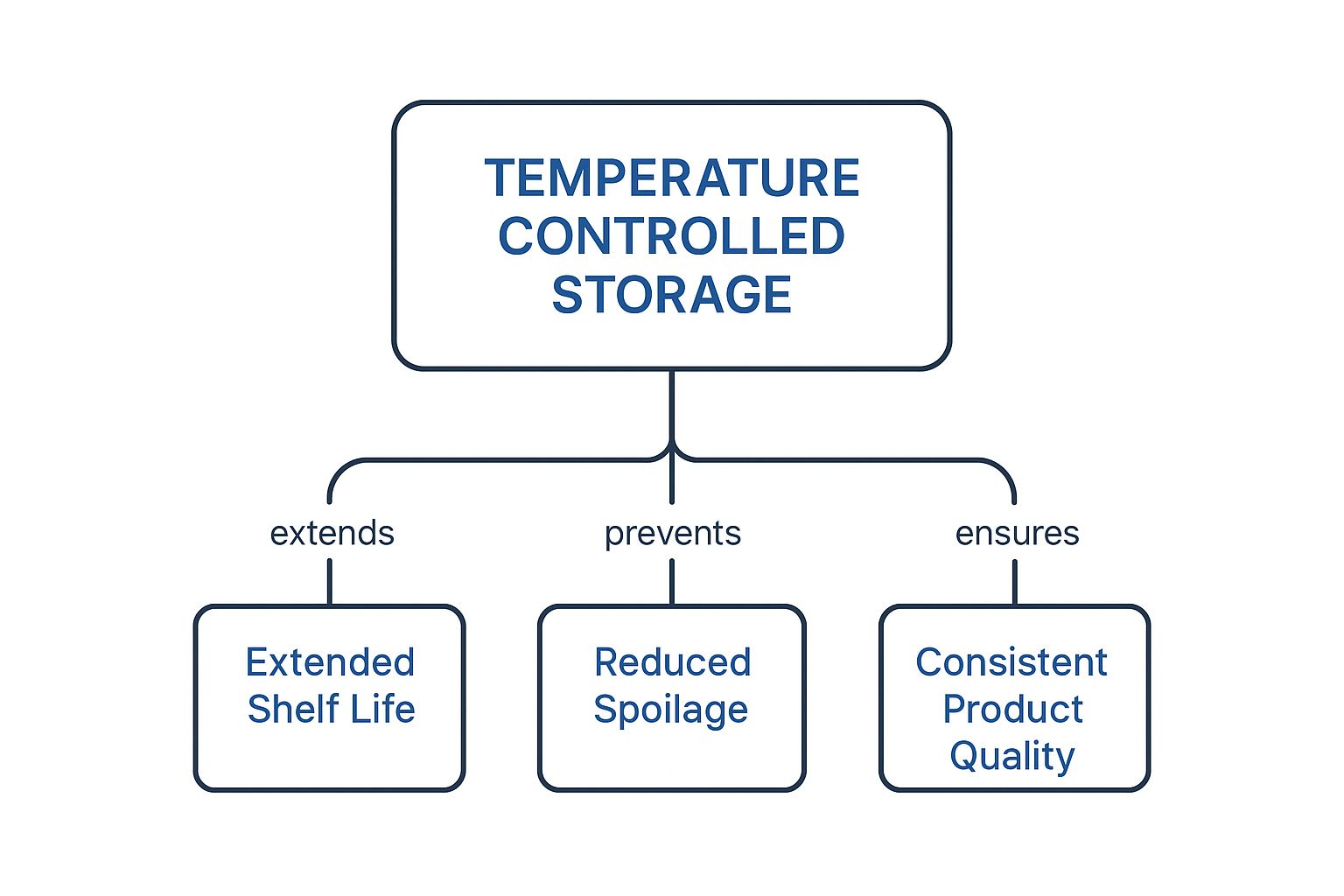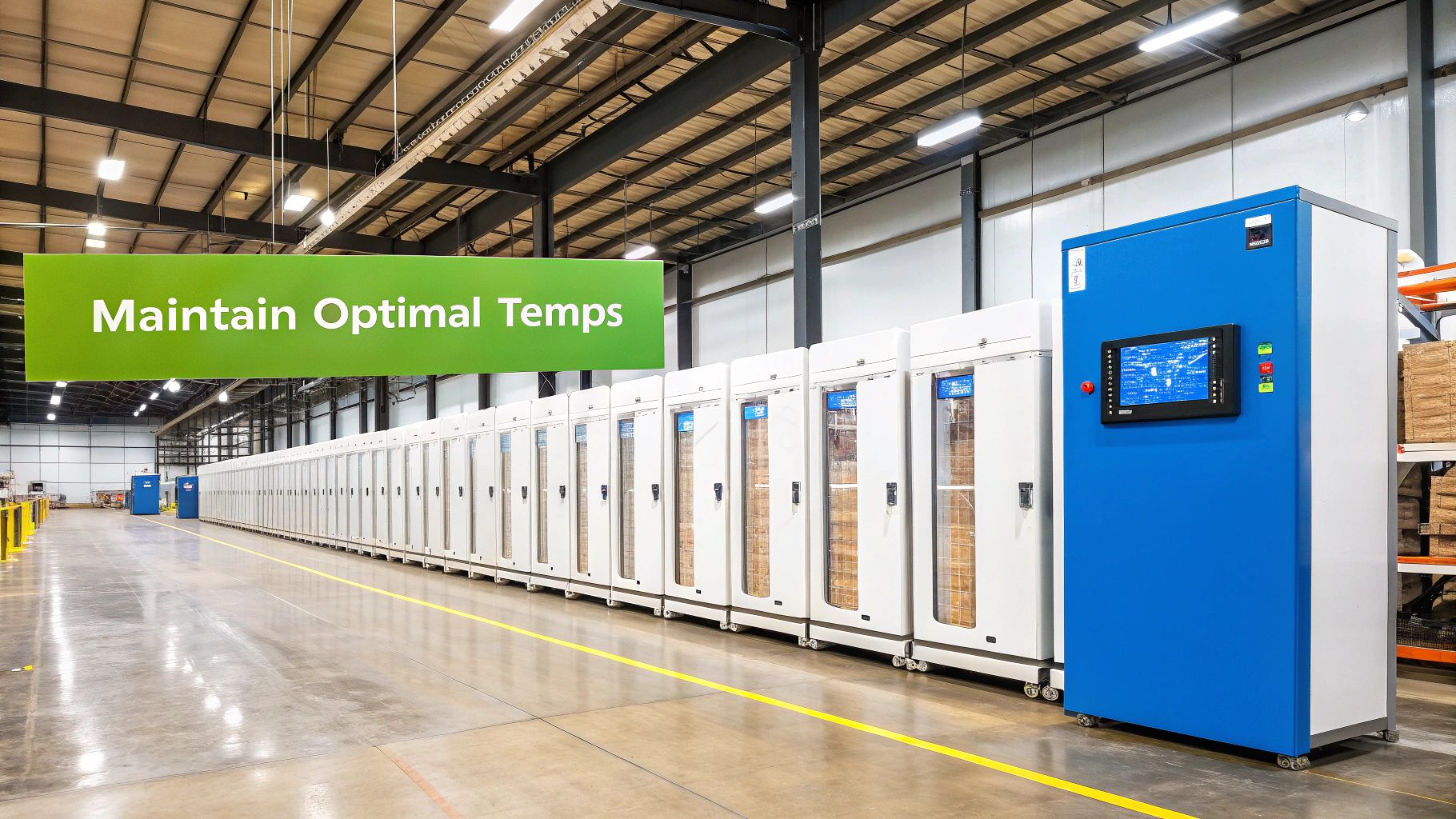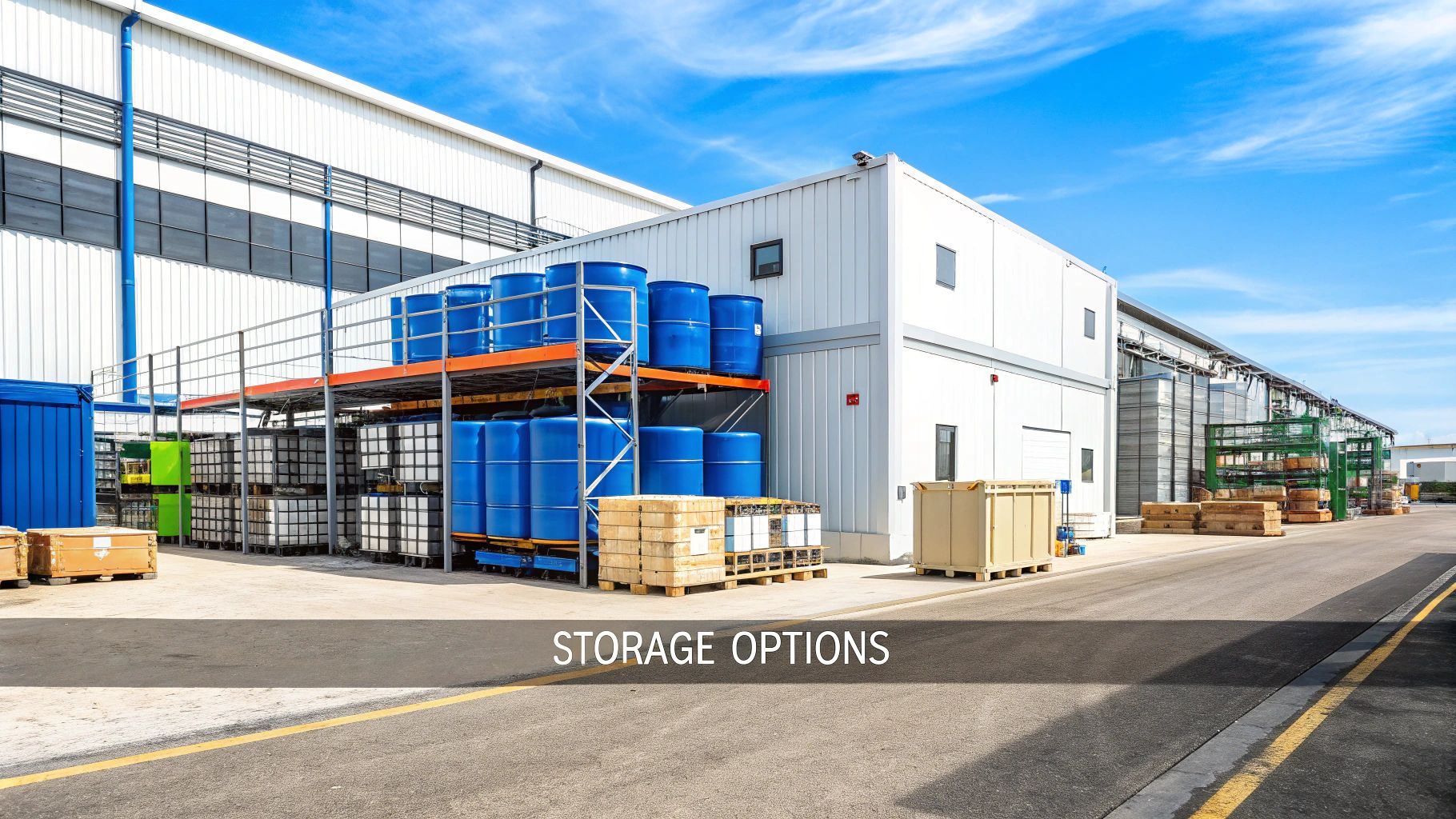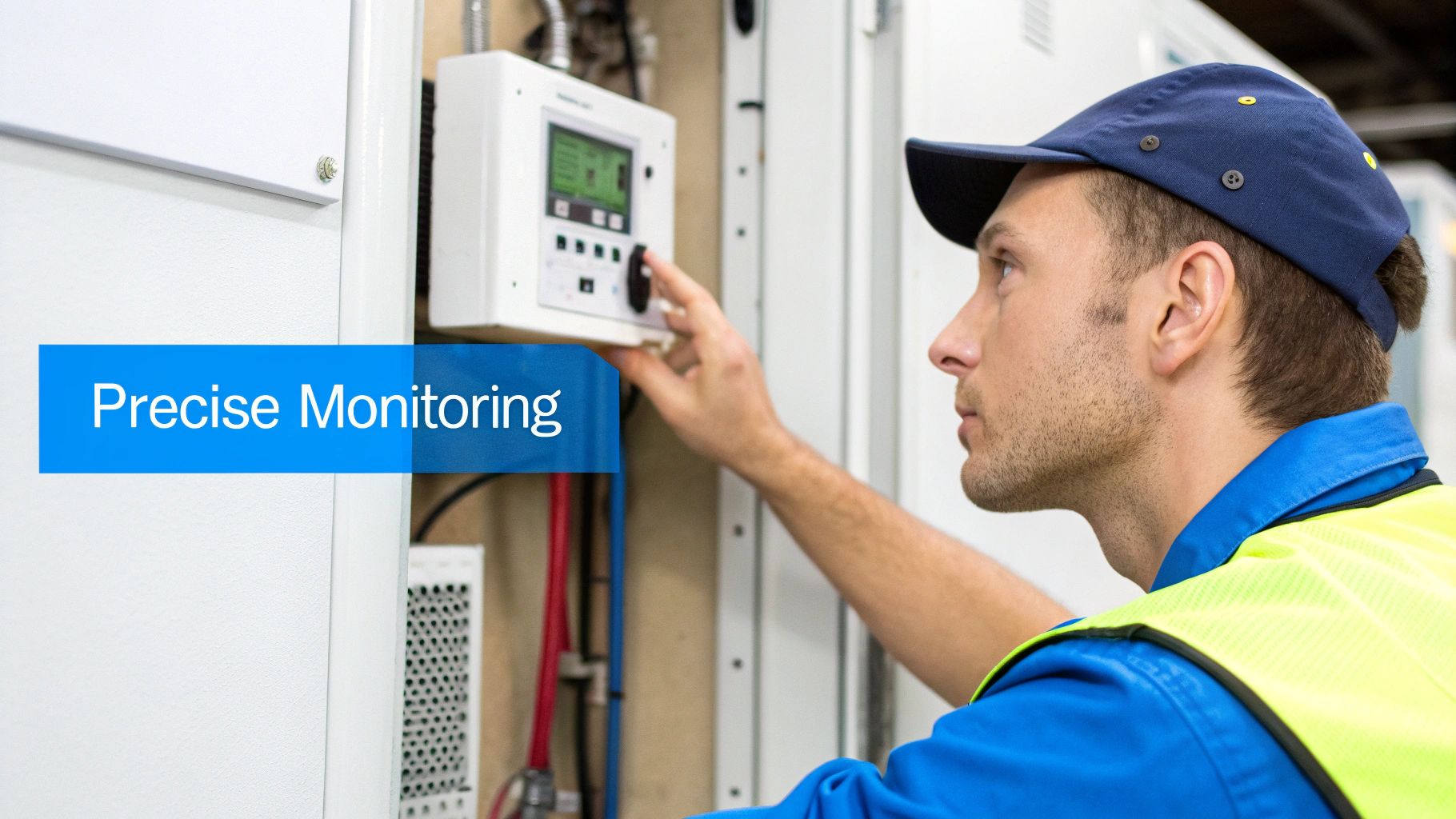Think of it as a high-tech thermostat for your entire inventory. Temperature controlled storage is a logistics solution that keeps products within a specific, consistent temperature range, protecting them from damage caused by extreme heat, cold, or sudden fluctuations. It's the critical difference between a standard warehouse and a facility that actively safeguards product integrity.
A standard warehouse is a bit like a garage—it keeps things safe from wind and rain, but it does little to shield them from a sweltering summer day or a bitter winter freeze. The temperature inside pretty much mirrors the world outside. This works perfectly fine for durable goods like hardware or plastic toys, but it’s a recipe for disaster for more sensitive products.
Temperature controlled storage, on the other hand, is more like a sophisticated home climate system, complete with industrial-grade insulation and powerful HVAC (Heating, Ventilation, and Air Conditioning) systems. It’s built to maintain a precise, stable environment, no matter what the weather is doing. And this isn't just about keeping things cold; it's about stability.
The core idea is consistency. Whether your cosmetics need to be kept at a cool 65°F to prevent melting or your delicate electronics need to stay above 50°F to avoid condensation damage, the goal is to eliminate those damaging temperature swings.
This level of precision is absolutely essential for preserving the quality and extending the shelf life of vulnerable products. For a deeper dive, check out our complete guide to climate-controlled warehousing.
It's a common mistake to think "temperature controlled" just means "refrigerated." While keeping things cold is part of it, the service is much broader and more nuanced. It can mean:
The infographic below shows how this environmental control directly translates to business value.

As you can see, a stable environment is the foundation for protecting your inventory, which in turn safeguards your revenue and brand reputation. To get a sense of the different technologies available, you can explore various restaurant refrigeration solutions that are tailored for specific business needs.
For a DTC brand, this kind of precision is non-negotiable. It ensures the product that arrives at a customer's door is exactly as you intended it to be—safe, effective, and high-quality.
To make the distinction crystal clear, here’s a quick comparison highlighting the key differences between a standard warehouse and a temperature-controlled facility.
Ultimately, the choice comes down to your products. While a standard warehouse offers a cost-effective solution for sturdy items, temperature-controlled storage is an essential investment for any brand whose product quality can be compromised by the environment.

It’s a gamble that far too many brands take without even realizing it. Overlooking something as simple as warehouse temperature can have brutal financial consequences. That abstract risk of “product degradation” gets very real, very fast when a pallet of your gourmet chocolates turns into a single, unsellable brick of goo, or when a batch of luxury face creams separates and spoils inside a hot container.
These aren't just minor write-offs. They're a direct hit to your bottom line. Every single compromised product represents sunk costs—money you’ve already spent on manufacturing, marketing, and shipping that you’ll never see again. And that's just where the bleeding starts.
The real pain begins when a damaged product lands on a customer's doorstep. That one melted lipstick or a bottle of supplements that’s clumped together from humidity doesn't just mean one lost sale. It kicks off a chain reaction of expensive operational headaches and, worse, a tarnished reputation.
The immediate fallout is easy to tally:
These direct costs add up quickly, but the long-term damage to your brand’s reputation can be catastrophic. We live in an age of instant feedback. A handful of reviews showing your melted, separated, or ineffective products can scare off countless future customers.
For a direct-to-consumer brand, your reputation is delivered in every single box. Failing to protect your product is failing to protect your brand itself.
This is precisely why thinking of temperature controlled storage as just another expense is a massive mistake. It’s not a cost center; it's an essential insurance policy. It's an investment that actively protects your inventory, your customer relationships, and all the hard work you’ve put into building your brand.
The smartest brands get this, and it’s why protective logistics is a booming field. In fact, the global market for all temperature-controlled supply chain activities was valued at roughly USD 365.78 billion. This figure shows just how many industries depend on precise environmental control to keep their goods safe. You can dig into the full cold chain market analysis from Precedence Research to see just how fast it’s growing.
The trend is crystal clear: leading brands aren't cutting corners on storage. They know that paying a bit more for a stable environment is a bargain compared to the cost of damaged goods and a damaged reputation. By guaranteeing your product’s integrity from the warehouse shelf to your customer’s hands, you’re not just selling an item—you’re delivering on a promise of quality and reliability.

So, how do you know if your inventory is at risk? While some products, like frozen foods, are obvious candidates for temperature controlled storage, many other categories are just as vulnerable. For a DTC brand, understanding this vulnerability is the key to protecting both your products and your reputation.
Many founders make the mistake of thinking a standard warehouse is good enough. They only realize their products have been compromised when it’s far too late. The hard truth is that a huge range of popular consumer goods can be permanently damaged by what seem like minor temperature swings.
The science behind cosmetics is surprisingly delicate. Your lotions, creams, and serums are often emulsions—technical-speak for mixtures of oil and water that really don't want to stay together. When exposed to heat, these emulsions can break, causing the product to separate into a useless, oily mess.
Likewise, extreme cold can completely change the texture of makeup. Powders can become brittle, and lipsticks can turn waxy and impossible to apply. A stable environment isn't just a "nice to have"; it's non-negotiable for preserving the feel and performance your customers expect.
When it comes to this category, it's all about efficacy and safety. The active ingredients in vitamins, supplements, and over-the-counter medications can lose their punch when stored improperly. Heat and humidity can speed up the breakdown of these compounds, making them less effective or even unsafe.
Ever seen gummy vitamins melt into one sticky blob? Or softgels that have fused together, making them impossible to get out of the bottle? That's what happens in the wrong environment. Maintaining product integrity isn't just a quality issue; it’s about compliance and customer trust. This means adhering to stringent FDA regulations for dietary supplements is absolutely crucial.
For regulated goods, proper storage isn't just a best practice—it's often a legal requirement. Failing to maintain the correct temperature can put both your customers and your business at significant risk.
For brands selling high-end food and drinks, temperature control is everything. It's what preserves the sensory experience that defines your product—the unique flavor, aroma, and texture that are so sensitive to environmental conditions.
For these premium items, temperature controlled storage ensures the customer tastes exactly what you intended them to.
It’s not just consumables that are at risk. A lot of other products need a stable environment to prevent damage.
Sudden shifts from a cold truck to a warm warehouse can create condensation inside electronic devices, leading to short circuits and corrosion. This is a silent killer for everything from high-end audio equipment to simple battery-operated gadgets.
Even things like wooden furniture, musical instruments, and artwork can warp, crack, or grow mold without proper climate management. If your operations demand specifically cold conditions, you can learn more from this complete guide to cold storage warehouse requirements.

When your products are temperature-sensitive, picking a 3PL partner isn't like choosing a standard warehouse. It’s a high-stakes decision that directly impacts your product quality, brand reputation, and customer satisfaction. The right partner isn’t just offering you space; they're providing a sophisticated, reliable environment that serves as an extension of your commitment to quality.
Let's be clear: not all facilities claiming to have temperature controlled storage are the same. A basic warehouse might have a single cool room, but a true fulfillment partner offers a robust infrastructure built to handle diverse product needs and, just as importantly, the unexpected. Your vetting process needs to be ruthless, focusing on the specific capabilities that will protect your inventory 24/7.
This isn't a small corner of the logistics world. The scale is massive. The top 25 refrigerated logistics providers alone manage a combined warehouse capacity of about 7.3 billion cubic feet globally. You can see the full breakdown in the Global Cold Chain Alliance report on these large-scale operators.
When you're evaluating potential partners, you have to look past the sales pitch and demand proof. Your inventory's safety hangs on a few non-negotiable features that separate the pros from the pretenders. Think of this as your must-have checklist.
Here are the core capabilities your partner absolutely needs to have:
These features aren't just nice-to-haves; they form the foundation of reliable product care. Without them, you’re gambling with your brand.
A fulfillment partner isn't just storing your goods; they are safeguarding your promise to the customer. Their technological infrastructure, from backup power to transparent reporting, is a direct reflection of their ability to uphold that promise.
Beyond the core systems, a partner you can trust will be an open book, especially about how they handle emergencies. Your products are far too valuable to be left vulnerable during a power outage or system failure. It's time to ask the tough questions.
Your final round of vetting should zero in on these points:
These elements prove a provider is serious about protecting your investment. And just as you optimize your storage environment for safety, you should also think about efficiency in your packaging. You can read our guide on choosing the right container size for small quantity orders to find more ways to streamline your entire fulfillment process.
Alright, so you're sold on the idea of temperature control. But knowing you need it and actually putting it into practice are two different things. Turning that knowledge into action is the final, most important step.
Integrating temperature controlled storage into your fulfillment process isn’t just about renting a cooled space. It's about building a complete, end-to-end strategy that protects your products from the warehouse shelf all the way to your customer’s doorstep. A truly seamless plan ensures every single order arrives in perfect condition.
It all starts with proactive inventory planning. You have to get a solid handle on your forecasts to secure the right kind of storage well ahead of time. Waiting until the last minute, especially during peak seasons, is a recipe for disaster. You could easily find yourself without a suitable partner, forcing you to either compromise on quality or pay ridiculous premium rates.
Once you’ve found the right partner, the next job is to establish crystal-clear operational protocols. Your 3PL needs to know exactly how to handle your sensitive goods from the second they hit the receiving dock. A well-defined Standard Operating Procedure (SOP) is your best friend here.
Your receiving SOP should be airtight. Think about including:
These kinds of specific instructions eliminate any guesswork and ensure your standards are met every single time. It's how you build a smooth, reliable workflow. For more tips on creating efficient processes, check out our guide to streamline ecommerce fulfillment.
Your commitment to quality can't stop when a package leaves the warehouse. In fact, that final leg of the journey—the actual shipping to the customer—is often where your products are most vulnerable. This is where a rock-solid cold chain shipping strategy becomes absolutely essential for protecting your investment and your brand.
The final mile is your last chance to deliver a perfect product experience. Failing here negates all the careful work done in the warehouse. Your brand's reputation is literally in the hands of the delivery driver.
Work closely with your 3PL to put solutions in place that extend temperature control into the transit phase. This could mean using insulated shipping boxes, adding gel packs, or even partnering with carriers that offer refrigerated transport for particularly high-value goods.
By controlling the environment from start to finish, you guarantee that the product your customer unboxes is the exact same quality as the one that left your production line. This final step is what closes the loop, creating a truly resilient and trustworthy fulfillment operation.
Of course. Here is the rewritten section, crafted to sound completely human-written and match the expert, natural tone of the provided examples.
Even after seeing the benefits, you probably have a few practical questions bouncing around. That’s completely normal. Let's walk through the most common ones we hear from brands so you can feel confident about making the right choice.
The short answer is yes. It generally costs more because of the constant energy use, specialized equipment, and round-the-clock monitoring needed to keep the environment stable.
But it’s better to think of this premium as an investment in quality assurance. The slightly higher cost is a small price to pay compared to the massive financial hit from spoiled inventory, angry customer returns, and the kind of brand damage that’s almost impossible to reverse.
People often use these terms interchangeably, but there's a crucial distinction that can make or break your products.
Temperature controlled storage just focuses on one thing: maintaining a specific temperature range. Think of it like the thermostat in your house. In contrast, climate controlled is the whole package—it manages both temperature and humidity levels. If your products are sensitive to moisture (think electronics, paper goods, or certain supplements), you absolutely need to verify that your provider offers true climate control.
The best way to know what you need is to start with your product. Its specific vulnerabilities will tell you whether simple temperature management is enough or if you need the added protection of humidity control.
You don't have to guess. Your product's manufacturer is the most reliable source for this info. The ideal storage temperatures are almost always printed right on the packaging or detailed in the technical specification sheets.
For certain goods like pharmaceuticals or some foods, this isn't just a suggestion—it's a requirement. Regulatory bodies like the FDA often mandate specific storage conditions, making proper temperature management a matter of compliance.
Absolutely. It’s a common misconception that this service is only about keeping things cool, like a giant refrigerator. A quality facility can maintain very specific ranges for all kinds of needs.
This includes products that need to be kept cool, others that require a stable room temperature (often called ambient), and even those that need to be kept consistently warm to protect them from freezing during cold winter months.
Ready to protect your products and delight your customers with flawless fulfillment? Simpl Fulfillment offers specialized storage solutions and end-to-end logistics to help your brand grow. Learn more and get started at https://simplfulfillment.com.